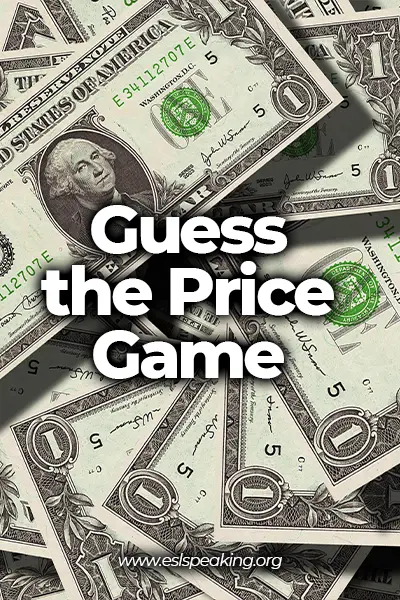Are you looking for a fun classroom activity or game? If yes, try the Guess the Price Game! It is an interactive and educational game that brings a refreshing twist to language learning. The game will make English learning more enjoyable and effective for ESL students. The game is easy but fun and can be tailored to different situations.

Guess the Price Game
The game involves presenting various everyday items, each with a distinct value, to ESL students. Students then guess the price of these items, utilizing their English language skills to express their estimations. This not only enhances their vocabulary but also develops their ability to communicate effectively.
How to Play
- The first student (or team) presents an item.
- Other students (or teams) make their best guess of the item’s price.
- Facilitate discussion and make students provide reasons for their guessing.
- The class says, “How much is it?” and the item owner reveals the price.
- The student (or team) with the closest guess earns a point.
- Repeat until everyone (or every team) takes a turn to present an item.
- The student (or team) with the highest point wins.
Preparation
Here’s what you need to prepare to play the game.
- Everyday Items: Collect a variety of items with clear price tags, ensuring they align with the students’ language proficiency level. You can ask students to prepare in advance, or use classroom objects that students already have.
- Whiteboard or Chart: Display the items and note down the guessed prices for discussion.
Benefits of Guess the Price Game
This is what your students will get out of this activity:
- Vocabulary Enhancement: The game incorporates a diverse range of items, from groceries to electronics, enriching students’ vocabulary with practical, real-world terms.
- English Speaking and Listening Skills: Guessing the prices encourages students to express themselves in English, promoting fluency and sharpening listening abilities as they learn from their peers.
- Communication Skills: Through teamwork and discussions, students will learn how to work with others and handle friendly competition.

Guess the Price Game in ESL Classes
Here are the two ways you can incorporate this price guessing game in your ESL class.
- Warm-up Activity: It works as a great icebreaker activity. Start your ESL class with this game as a lively warm-up, setting a positive and engaging tone for the lesson.
- Theme-Based Learning: Tailor the game to fit your lesson themes, reinforcing language concepts related to specific topics.
Other ESL Activities
If you are looking for more fun classroom game and activity ideas, check out the following list:
- 100 Family Feud Questions and Answers
- Opposite Games & Activities
- ESL Reading Games, Activities, Lesson Plans
- ESL Warm-Up Activities and Games
- Puzzle Finder Ice Breaker Activity
FAQs About Guess the Price Game
Here are some of the most frequently asked questions about the price guessing game.
What is the guess the price show?
“The Price Is Right” is a fun TV game show where contestants guess the prices of different products to win prizes. They play games like guessing the cost of items, and the ones who guess closest without going over get to spin a big wheel for more prizes. The show is known for its excitement, colorful prizes, and the famous phrase “Come on down!” that invites contestants to join the game.
What is the Guess the Price game?
The “Guess the Price” game is a fun and interactive classroom activity where students guess the price of others’ items. It is a game that helps ESL students improve their speaking and listening skills.
How do you play games in the classroom?
Here’s the steps to playing games in a classroom:
- Choose Suitable Games: Select games that match learning goals and suit the students’ age and language proficiency.
- Explain Rules Clearly: Introduce the game rules, ensuring students grasp how to play and understand relevant language or concepts.
- Form Teams: Divide students into small teams to foster collaboration and teamwork.
- Provide Guidance: Monitor student progress during the game, offering assistance when needed. Facilitate discussions and address questions.
- Conduct Debriefing: After the game, discuss learning outcomes, reinforce key concepts, and address any challenges or questions that arose during the activity.
What are 5 education games for ESL students?
Some educational games for ESL students include Scrabble, Pictionary, Would you rather, jeopardy, and Bingo.
What are some interactive classroom games?
Here are some interactive classroom game ideas: escape room challenges, interactive whiteboard games, online platform games, role-playing games, and simulation games.

Guess the Price Game: Join the Conversation
What are your thoughts on this simple but exciting ESL activity that is based on a TV show? Let us know in the comments. We’d love to hear from you.





Leave a Reply